
1947 and 1948 continued to produce toon weather forecasts of frosty mornings, wild waves, and unexpected summer showers. Caught in the downdrafts are classic stars Donald Duck, Pluto, Porky Pig, and Chuck Jones’ Three Bears – along with a couple of bouncing-ball Screen Sings, and classic elements of another of Disney’s 1940’s “package” features.
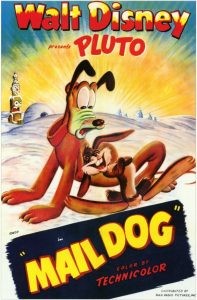 Mail Dog (Disney/RKO, Pluto, 11/14.47 – Charles Nichols, dir.) – Mail plane 51 is having trouble getting through a rocky mountain pass in the height of winter. Ice is forming on the wigs, and the pilot turns back. He is instructed to drop his mail sack by parachute at Outpost No. 5, where it will be carried through to Quagmire Airport by dog sled. Such dog is Pluto, who receives the mail drop by way of a slap in the face from the descending pouch. Pluto rigs up a sled, but can’t seem to stay ahead of it on a downward slope. The sled gets underfoot, sweeping Pluto away and into a snowbank. When Pluto emerges from the white stuff, he finds the mail pouch has tumbled out, and is resting in the open claws of a carved figure on an Indian totem pole. Pluto challenges the ferocious looking face, but his challenge is met by the echo of his own bark within the hollow totem. He runs in panic, his neck inside the loop of the pouch strap, finally pulling the mail pouch free. Pluto proceeds ahead with more caution.
Mail Dog (Disney/RKO, Pluto, 11/14.47 – Charles Nichols, dir.) – Mail plane 51 is having trouble getting through a rocky mountain pass in the height of winter. Ice is forming on the wigs, and the pilot turns back. He is instructed to drop his mail sack by parachute at Outpost No. 5, where it will be carried through to Quagmire Airport by dog sled. Such dog is Pluto, who receives the mail drop by way of a slap in the face from the descending pouch. Pluto rigs up a sled, but can’t seem to stay ahead of it on a downward slope. The sled gets underfoot, sweeping Pluto away and into a snowbank. When Pluto emerges from the white stuff, he finds the mail pouch has tumbled out, and is resting in the open claws of a carved figure on an Indian totem pole. Pluto challenges the ferocious looking face, but his challenge is met by the echo of his own bark within the hollow totem. He runs in panic, his neck inside the loop of the pouch strap, finally pulling the mail pouch free. Pluto proceeds ahead with more caution.
A jack rabbit with huge feet is freezing and blue with cold, pacing the snow and blowing on his hands to try to keep warm. Pluto playfully puts a scare into him with a loud bark. But when the hare looks back to see what the danger was, all he sees is Pluto’s belly – transformed in his imagination into the warmth of a pot-bellied stove. The rabbit is no longer afraid, and sidles up to Pluto, briefly warming himself to a warm brown, while Pluto is turned blue by absorption of the cold from the hare’s body. Pluto tries to chase the rabbit away – but the rabbit gets another idea, and doubles back for the warmth of the protective blanket covering the mail pouch on the sled. Concealed under it, he remains unseen by Pluto. Pluto lies down in frustration upon the blanket, not noticing the hare’s long feet protruding from underneath, which take on the movements and gestures of two additional front paws below Pluro’s person, offering Pluto a shrugging gesture as he looks at the camera as if to say, “I don’t know”. Pluto tests out the situation by sniffing at his own front paws, then at the rabbit’s feet – wincing from their unfamiliar smell. The secret is out, and the rabbit takes off, accidentally snagging the mail pouch around his neck. The chase develops into a wild ride as the sled once again overtakes Pluto, also sweeping up the rabbit, for a careening toboggan ride through the mountain passes, finally coming to a stop at the very airfield Pluto was bound for. As the sled abruptly halts in a snowbank, the mail pouch flies off the rabbit’s neck – right into the hands of a waiting pilot, who thanks them for a speedy delivery. The plane takes off (in what appears to be reused animatiion from “Pluto and the Armadillo”), and Pluto makes friends with the rabbit, offering him a cozy tide home under the sled’s blanket, for the iris out.
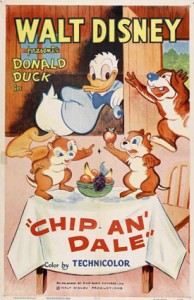 Chip ‘n’ Dale (Disney/RKO, Donald Duck, 11/28/47 – Jack Hannah, dir.) – Disney’s chipmunks, who had already appeared in a few episodes, finally receive a number of firsts – their first meeting with Donald Duck, their first supervision by their most popular director, Jack Hannah, and their official names, as stated in the title of the picture. They are also now more distinguishable from one another in their facial features, with Dale drawn with a larger, redder nose and prominent front teeth with considerable space between, similar in appearance to Goofy, and correspondingly noting the comparative goofiness of his personality. However, the characters are not yet fully developed in the vocal department, their dialogue being only meaningless jibber-jabber on a sped-up track. It would be almost another two years before the chips would receive any substantial dialogie script, with some audible lines in “Winter Storage” and a nearly complete speaking track in “All In a Nutshell”. The efforts of Hannah achieved notoriety, earning the film an Academy Award nomination.
Chip ‘n’ Dale (Disney/RKO, Donald Duck, 11/28/47 – Jack Hannah, dir.) – Disney’s chipmunks, who had already appeared in a few episodes, finally receive a number of firsts – their first meeting with Donald Duck, their first supervision by their most popular director, Jack Hannah, and their official names, as stated in the title of the picture. They are also now more distinguishable from one another in their facial features, with Dale drawn with a larger, redder nose and prominent front teeth with considerable space between, similar in appearance to Goofy, and correspondingly noting the comparative goofiness of his personality. However, the characters are not yet fully developed in the vocal department, their dialogue being only meaningless jibber-jabber on a sped-up track. It would be almost another two years before the chips would receive any substantial dialogie script, with some audible lines in “Winter Storage” and a nearly complete speaking track in “All In a Nutshell”. The efforts of Hannah achieved notoriety, earning the film an Academy Award nomination.
A snowy morning finds Donald attempting to stay out of the chilling breezes inside a log cabin in the woods. He lies huddled in his bed, bill chattering just like teeth, attempting to keep an old army blanket close upon his person. However, his arms and feet are waging a losing battle against one another, as his hands clutch the blanket to his neck, exposing his feet, which retaliate by yanking the blanket back down to expose Donald’s neck and shoulders again. Donald can’t keep his eyes shut, and looks up to see what is the condition of the fireplace. Whatever fire may have been there has gone completely out, and a small mound of snow has built up in the hearth from snowflakes drifting in through the chimney. Donald rises from bed, complaining about the freezing weather and how no one gets any sleep around here. Inspecting the fireplace wood box, he finds his supply is empty. No choice but to don winter garb, and venture out into the woods with an axe. He picks out a small tree to chop, which is of course the home of Chip and Dale. They are thrown out of a knothole as the tree falls, and Donald walks off with the fallen log. The chipmunks follow to recover their property (though it is never established what exactly they plan to do with it once they recover the log – after all, it is already cut down, so do they plan to live in it sideways?)
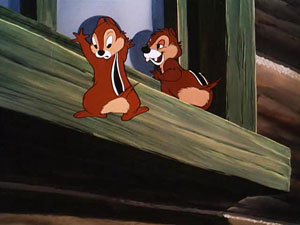 Hannah builds the chipmunks’ personality with some cute “business”, as they track Donald back to the cabin. Chip has Dale boost him up on his back, so that Chip can peer in Donald’s window. Suddenly, Dale appears at the windowsill beside Chip. Chip looks down, and finds he is standing on nothing because Dale has moved, and plops helplessly into the snow below. The chipmunks enter the cabin, and try to put out the fire Donald has started in the hearth, by taking large gulps of water in their cheeks, and spitting it on the fire. Dale’s timing is off, however, and one of his spits hits Chip squarely in the face instead of the log. When the fire is out, the chipmunks try to sneak the log out of the cabin right under Donald’s nose. The duck, however, spots them, and refers to them as “termites”. As the chipmunks approach the door to exit, Donald gently lifts the log from their paws, allowing them to exit the cabin thinking they are still carrying their prize, but in fact empty-handed. The chipmunks try a new approach, dropping snowballs down the chimney to smother the fire again. One scores a direct hit on Donald as he looks up the flue to see what’s going on. He appears out of the chimney top, with his head encased in the snowball, and catches the chipmunks. Molding them into a snowball, Donald rolls them down the roof slope to send them for “a ride”. One good snowball deserves another, and Chip sets himself high on the crest of a nearby hill, drawing a bead upon the door of Donald’s cabin as a target. Testing the breeze to make sure his aim will not be deflected, Chip forms a small snowball, and bowls it down the hill. It begins growing and growing as it accumulates snow, and soon is of monstrous proportions. A whistle to Dale, and Dale, stationed at the door of the cabin, knocks for Donald. Donald is suckered into answering the unexpected knock, as Dale sidesteps out of the way. Precision timed, the snowball arrives just as Donald opens the door, sweeping the duck backwards through the cabin and out the rear doorway, where the impact knocks the rear door off its hinges, the snow taking the door with it, and Donald encased inside. As the snow comes to a stop, it and the door appear to have taken the shape of a refrigerator. The chipmunks pass, carrying away their home into the woods. Dale stops momentarily, to open the door off the snow, revealing Donald’s tail sticking out of the icy block. Dale rears back, and gives Donald’s fanny a well-deserved kick, before picking up the log again to carry it away for the iris out. (Note a continuity error that appears twice in the film, as two chipmunks are shown carrying the log in all but a tail-away perspective shot, which appears to depict Dale carrying the log all by himself.)
Hannah builds the chipmunks’ personality with some cute “business”, as they track Donald back to the cabin. Chip has Dale boost him up on his back, so that Chip can peer in Donald’s window. Suddenly, Dale appears at the windowsill beside Chip. Chip looks down, and finds he is standing on nothing because Dale has moved, and plops helplessly into the snow below. The chipmunks enter the cabin, and try to put out the fire Donald has started in the hearth, by taking large gulps of water in their cheeks, and spitting it on the fire. Dale’s timing is off, however, and one of his spits hits Chip squarely in the face instead of the log. When the fire is out, the chipmunks try to sneak the log out of the cabin right under Donald’s nose. The duck, however, spots them, and refers to them as “termites”. As the chipmunks approach the door to exit, Donald gently lifts the log from their paws, allowing them to exit the cabin thinking they are still carrying their prize, but in fact empty-handed. The chipmunks try a new approach, dropping snowballs down the chimney to smother the fire again. One scores a direct hit on Donald as he looks up the flue to see what’s going on. He appears out of the chimney top, with his head encased in the snowball, and catches the chipmunks. Molding them into a snowball, Donald rolls them down the roof slope to send them for “a ride”. One good snowball deserves another, and Chip sets himself high on the crest of a nearby hill, drawing a bead upon the door of Donald’s cabin as a target. Testing the breeze to make sure his aim will not be deflected, Chip forms a small snowball, and bowls it down the hill. It begins growing and growing as it accumulates snow, and soon is of monstrous proportions. A whistle to Dale, and Dale, stationed at the door of the cabin, knocks for Donald. Donald is suckered into answering the unexpected knock, as Dale sidesteps out of the way. Precision timed, the snowball arrives just as Donald opens the door, sweeping the duck backwards through the cabin and out the rear doorway, where the impact knocks the rear door off its hinges, the snow taking the door with it, and Donald encased inside. As the snow comes to a stop, it and the door appear to have taken the shape of a refrigerator. The chipmunks pass, carrying away their home into the woods. Dale stops momentarily, to open the door off the snow, revealing Donald’s tail sticking out of the icy block. Dale rears back, and gives Donald’s fanny a well-deserved kick, before picking up the log again to carry it away for the iris out. (Note a continuity error that appears twice in the film, as two chipmunks are shown carrying the log in all but a tail-away perspective shot, which appears to depict Dale carrying the log all by himself.)
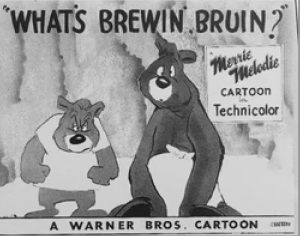 What’s Brewin’. Bruin? (Warner, Three Bears, 2/28/48 – Charles M. (Chuck) Jones, dir.) – Papa, Mama, and Baby (Junyer) Bear, first seen in “Bugs Bunny and the Three Bears”, receive their first solo starring vehicle. As winter snow falls heavily outside their half-cave, half-house dwelling, the bears kill time in their living room, as Mama and Papa engage in a friendly game of gin rummy. Junyer busies himself reading Warner comics, appearing on the surface oblivious to the game, but is prone to look over the players’ shoulders at their hands. Mama maintains an emotionless poker face, while Papa fusses and frets over which card to play, glancing down at a score sheet of past hands, extending clear down to the floor, with Dad not showing a single game won. As Papa reaches for a card to discard, Junyer shakes his head no. Dad reaches for another card, and gets the same reaction from his son. A third card, however, causes Junyer to crane his neck for a view of Mama’s hand, then nod a reassuring yes to Papa. Papa gracefully deposits his discard on the table. It is immediately snatched up by Mama, who for the umpteenth time declares “Gin”. Papa explodes – literally – then socks Junyer in the face for his “help”. “Well, are we gonna stay up all winter? Can’t you see it’s almost half-past November?”, shouts Dad, pointing to a custom alarm clock depicting months instead of hours. The three settle down for a long winter’s nap.
What’s Brewin’. Bruin? (Warner, Three Bears, 2/28/48 – Charles M. (Chuck) Jones, dir.) – Papa, Mama, and Baby (Junyer) Bear, first seen in “Bugs Bunny and the Three Bears”, receive their first solo starring vehicle. As winter snow falls heavily outside their half-cave, half-house dwelling, the bears kill time in their living room, as Mama and Papa engage in a friendly game of gin rummy. Junyer busies himself reading Warner comics, appearing on the surface oblivious to the game, but is prone to look over the players’ shoulders at their hands. Mama maintains an emotionless poker face, while Papa fusses and frets over which card to play, glancing down at a score sheet of past hands, extending clear down to the floor, with Dad not showing a single game won. As Papa reaches for a card to discard, Junyer shakes his head no. Dad reaches for another card, and gets the same reaction from his son. A third card, however, causes Junyer to crane his neck for a view of Mama’s hand, then nod a reassuring yes to Papa. Papa gracefully deposits his discard on the table. It is immediately snatched up by Mama, who for the umpteenth time declares “Gin”. Papa explodes – literally – then socks Junyer in the face for his “help”. “Well, are we gonna stay up all winter? Can’t you see it’s almost half-past November?”, shouts Dad, pointing to a custom alarm clock depicting months instead of hours. The three settle down for a long winter’s nap.
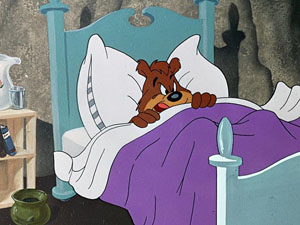 Papa’s dreams of peaceful sleep are not to be. Mama snores, her inhales and exhales raising and lowering a flapping windowshade above her. Junyer squeaks the floorboards while rocking in a cradle four sizes too small for him, then tosses and turns to collapse the cradle into splinters. He starts bawling about having no place to sleep, and Papa is forced to take Junyer into his own bed. Junyer repeatedly rolls over in his sleep, crushing Papa from his sheer weight. Papa cruelly holds up a sharp straight pin in the path where Junyer will roll – but the pin is crushed and bent the same as Papa. Papa ultimately builds a wooden partition onto the bed, with braces to hold Junyer in place on his own side. Next aggravation is a drip from the tree roots in the ceiling of the cave, which hits the bed, then Papa straight in the eye. Papa tries sliding the bed to the far end of the cave – but the water drops follow an extended trail of household objects, and somehow find a path clear across to plink Pop in the eye again. Junyer is ordered to plug up the hole, which he does with one finger like the boy and the dike. It doesn’t work, as water somehow spouts out of Junyer’s ears. Papa tries to plug Junyer’s ears – only to have the water travel through his own fingers and out his own ears. Papa shoves Junyer out of the way, and plugs the hole himself with an old pair of long underwear. All this accomplishes is to allow the water to fill the underwear to overflowing – then explode in a flood down upon Papa’s head.
Papa’s dreams of peaceful sleep are not to be. Mama snores, her inhales and exhales raising and lowering a flapping windowshade above her. Junyer squeaks the floorboards while rocking in a cradle four sizes too small for him, then tosses and turns to collapse the cradle into splinters. He starts bawling about having no place to sleep, and Papa is forced to take Junyer into his own bed. Junyer repeatedly rolls over in his sleep, crushing Papa from his sheer weight. Papa cruelly holds up a sharp straight pin in the path where Junyer will roll – but the pin is crushed and bent the same as Papa. Papa ultimately builds a wooden partition onto the bed, with braces to hold Junyer in place on his own side. Next aggravation is a drip from the tree roots in the ceiling of the cave, which hits the bed, then Papa straight in the eye. Papa tries sliding the bed to the far end of the cave – but the water drops follow an extended trail of household objects, and somehow find a path clear across to plink Pop in the eye again. Junyer is ordered to plug up the hole, which he does with one finger like the boy and the dike. It doesn’t work, as water somehow spouts out of Junyer’s ears. Papa tries to plug Junyer’s ears – only to have the water travel through his own fingers and out his own ears. Papa shoves Junyer out of the way, and plugs the hole himself with an old pair of long underwear. All this accomplishes is to allow the water to fill the underwear to overflowing – then explode in a flood down upon Papa’s head.
Stanza three finds Mama and Papa in a battle over whether the window should be left open or closed. Mama is a fresh-air fiend, and repeatedly opens the window, even though winter’s icy winds continue to blow fiercely outside. Papa slams it shut, but Mama opens it again. Papa nails the bottom pane shut, but Mama opens the top one. Papa seals up the entire window with a wall of bricks, but Mama merely slides the wall upwards as if it were another window frame. A blast of the sleet-filled wind covers Papa with a coating of snow, and dim-witted Junyer takes the opportunity to add a hat and a broom, converting Papa into a snowman.
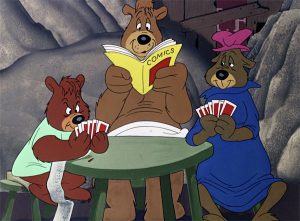 Stanza four turns the whole household upside down, as a sneeze produced by a pillow feather blown onto Papa’s nose dislodges a wall-mounted moose head, which lands over Papa’s head. Junyer finds what appears to be a moose in bed with him, and attacks it with a large mallet. Mama awakens to the commotion, and takes things to a further extreme, grabbing a shotgun, and pursuing the “moose” with gunfire. By the time the chasing is done, Papa has been soundly bopped and rifle-grazed. He retaliates with a mallet blow to Junyer, and beckons his embarrassed wife to come here. The final sequence finds Papa in blissful peace, having securely bound and gagged both his wife and offspring in their respective beds, and silenced the clapper of the alarm clock. Papa’s eyes close, and all is quiet. That is, until things begin popping outside. The sun peeps over a hill, buds begin to bloom, the ice melts off the stream and cave roof, and all manner of wild animals become active, their howls and calls making a dinning racket. It is already spring! Papa opens the shutter of a window, gazing out at this unwelcome sight with a look of helpless dismay. But his fiery temper won’t stay dormant for long, and he reacts with a bellowing shout of “QUIET!!!” All the action in the forest rapidly shifts into reverse, the buds disappear, and the sun goes back behind the horizon, while gentle snow resumes its falling. Looks like winter will be hanging around a little longer this year than usual, and Papa closes the shutters, with a happy satisfied smile on his face, knowing for once that he’ll get his needed rest.
Stanza four turns the whole household upside down, as a sneeze produced by a pillow feather blown onto Papa’s nose dislodges a wall-mounted moose head, which lands over Papa’s head. Junyer finds what appears to be a moose in bed with him, and attacks it with a large mallet. Mama awakens to the commotion, and takes things to a further extreme, grabbing a shotgun, and pursuing the “moose” with gunfire. By the time the chasing is done, Papa has been soundly bopped and rifle-grazed. He retaliates with a mallet blow to Junyer, and beckons his embarrassed wife to come here. The final sequence finds Papa in blissful peace, having securely bound and gagged both his wife and offspring in their respective beds, and silenced the clapper of the alarm clock. Papa’s eyes close, and all is quiet. That is, until things begin popping outside. The sun peeps over a hill, buds begin to bloom, the ice melts off the stream and cave roof, and all manner of wild animals become active, their howls and calls making a dinning racket. It is already spring! Papa opens the shutter of a window, gazing out at this unwelcome sight with a look of helpless dismay. But his fiery temper won’t stay dormant for long, and he reacts with a bellowing shout of “QUIET!!!” All the action in the forest rapidly shifts into reverse, the buds disappear, and the sun goes back behind the horizon, while gentle snow resumes its falling. Looks like winter will be hanging around a little longer this year than usual, and Papa closes the shutters, with a happy satisfied smile on his face, knowing for once that he’ll get his needed rest.
The Golden State (Paramount/Famous, Screen Song, 3/13/49 – Seymour Kneitel, dir.) – A typical travelogue spoof in spot-gag style, on the history and attractions of California. Of course, the Famous boys can’t resist taking the usual jabs at California weather. Oddly, their first gag is in reverse, showing a steady line of tourists crossing the border from Nevada to California – with solid rain on the Nevada side of the line and sunshine on the California side. (If this were really the case, one could hardly account for most of Nevada consisting of desert.) By the end of the cartoon, the tables have turned, and a closing shot of a balmy California day suddenly darkens and turns cloudy, then breaks out in pouring rain. The scene is quickly blocked from view by an animated hand of a human, who pulls a curtain down in front of the camera lens. On the curtain is written, “CENSORED – California Chamber of Commerce”.
Winter Draws On (Paramount/Famous, Screen Song, 3/19/49 – Seymour Kneitel, dir.) – Cold, icy breezes appear in the forest, as the first advance signs of Winter’s approach, The bottom almost falls out of a wall thermometer, which holds up its ice-blue mercury like a sagging pot belly. Buzzy the crow appears in a one-scene cameo, packing a traveling bag – “The iceman cometh – and South we birds go.” Various birds travel by different means. A nest is tied to a balloon, serving as a gondola. A wife bird with a henpecked husband flies carrying only one light suitcase in her claws – while her husband labors under the weight of about eight heavy bags. A canary locked in a cage joins the migration, flying while clutching the perch bar within the cage in its claws, to take the whole cage along with him. A hobo bird “rides the rods” by reclining on the landing gear under a commercial plane. Even the metal rooster atop a weather vane detaches from its mounting to follow the flocks. A pair of ducks remain behind, waiting on an egg in their nest that is late to hatch. Papa “candles” the egg to see what is going on inside, but the chick pulls a windowshade down inside the egg so that Pop won’t disturb his internal slumber. When hot water bottles fail to produce any results, and the snow begins to fall, Pop speeds things along by inserting a matchstick into a hole in the eggshell, then lighting the match – giving the chick an internal hotfoot that makes him leap out of the shell, hopping around in pain. He transforms into the bouncing ball, as Mom and Pop are finally able to carry him on their backs to join the migration, to the tune “Alabamy Bound”. (Talk about a money-saver. A POV shot traveling in perspective down a set of railroad tracks had been used behind the song lyric on the cartoon “The Golden State” discussed above. A mere few days later, the same animation is reused again, behind the lyrics of this song!) The birds arrive at the Mason-Doxon line, where the snow ends as abruptly as the rain usually begins at the California border. A statue, likely of Andrew Jackson, comes to life at the sight of the birds, opening a protective umbrella over its head and shoulders, and grumbles, “It’s those consarn Yankees again.”
He’s a nice copy – translated into Greek:
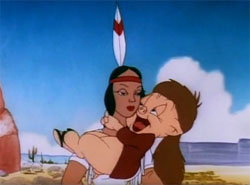 Nothing But the Tooth (Warner, Porky Pig, 5/1/48 – Arthur Davis, dir.), receives a very short honorable mention. Pioneer Porky Pig sets off in a covered wagon (inflated to full canvas size at a local filling station) to participate in the California gold rush – which really only consists of one prospector’s spotting of another’s gold tooth, and staking a claim on the dental filling within the second prospector’s mouth. When Porky reaches California, it is the usual – cross the borderline and immediately pass from brilliant sunshine into driving rain. Even his horse wears goggles with the usual built-in windshield wipers to be ready for such emergency – digging back to Micjey Mouse and Willie Whopper for the old gag. Porky’s gold strike turns out to be nothing more than that of the original prospector – as he too finds the shiny gold filling of a midget Indian who has been pursuing him all through the picture.
Nothing But the Tooth (Warner, Porky Pig, 5/1/48 – Arthur Davis, dir.), receives a very short honorable mention. Pioneer Porky Pig sets off in a covered wagon (inflated to full canvas size at a local filling station) to participate in the California gold rush – which really only consists of one prospector’s spotting of another’s gold tooth, and staking a claim on the dental filling within the second prospector’s mouth. When Porky reaches California, it is the usual – cross the borderline and immediately pass from brilliant sunshine into driving rain. Even his horse wears goggles with the usual built-in windshield wipers to be ready for such emergency – digging back to Micjey Mouse and Willie Whopper for the old gag. Porky’s gold strike turns out to be nothing more than that of the original prospector – as he too finds the shiny gold filling of a midget Indian who has been pursuing him all through the picture.
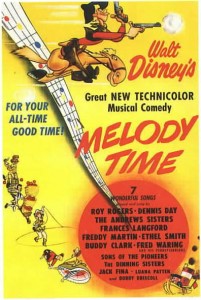 Another Disney musical package feature, Melody Time (Disney/RKO, 5/27/48), includes two uses of weather phenomena within its segments. The finale element, “Pecos Bill”, includes in its theme song a verse narrating one of the tall-tale feats of phenomenal cowboy skill that made Pecos a legend in his own time. He encounters a bucking Texas cyclone sweeping across the plains, and addresses it by hopping atop it and strapping a saddle upon its back. He rides the funnel cloud like a wild bronco, as the song describes: “And while that cyclone bucked and flitted, Pecos rolled a smoke and lit it – and he tamed that ornery wind down to a breeze.” This sequence is frequently cut today to remove the smoking reference – but did receive an uncut official release in the early days of VHS on a double-bill with the short, “Paul Bunyan”.
Another Disney musical package feature, Melody Time (Disney/RKO, 5/27/48), includes two uses of weather phenomena within its segments. The finale element, “Pecos Bill”, includes in its theme song a verse narrating one of the tall-tale feats of phenomenal cowboy skill that made Pecos a legend in his own time. He encounters a bucking Texas cyclone sweeping across the plains, and addresses it by hopping atop it and strapping a saddle upon its back. He rides the funnel cloud like a wild bronco, as the song describes: “And while that cyclone bucked and flitted, Pecos rolled a smoke and lit it – and he tamed that ornery wind down to a breeze.” This sequence is frequently cut today to remove the smoking reference – but did receive an uncut official release in the early days of VHS on a double-bill with the short, “Paul Bunyan”.
More notable was “Little Toot”, a musical story told in song and rhyme by the Andrews Sisters. If the “Pedro” element of “Saludos Amigos” was the precursor of the later Disney franchise “Planes”, then “Little Toot” could serve as the pilot for a new franchise of “Ships”. The same idea – a whole community of living ocean-going vessels, and how they interact. The idea was not in fact Disney’s, apparently deriving from a children’s book. But its treatment on film follows a straight path in style from “Pedro” to “Johnny Fedora and Alice Blue Bonnet” and on through the future productions, “The Little House” and “Susie, the Little Blue Coupe”, finally leading to “Cars”. Little Toot is a playful youngster of a tugboat, prone to pulling pranks in the shipyard (such as blowing smoke into the portholes of passing ocean liners), while his dad, Big Toot, is a hard-working adult tug, much in demand for piloting large ships to the docks. The little one makes a general nuisance of himself, until a near brush with a police boat scares him straight, into a resolve to try to make good. He decides to attempt to help his Pop bring in a huge ocean liner. However, not thinking to take on a tow line from the ship’s bow, he does the unthinkable – pushes on the ship’s stern, directly on the rudder. Instead of propelling the ship forward, he causes it to turn out of control, and into a spin that drags even his father out of his intended path. Nearly causing a whirlpool from its own wake, the ship careens between the narrow docks, passing the shoreline, and crashes right up onto the land, partially collapsing several buildings along the way.
 This being a cartoon, the full legal repercussions of this travesty are not clearly explored. Who paid for all the wreckage? Insurance? Big Toot’s life savings? Hard to say. All we know, is Little Toot is branded a criminal, and escorted in irons by two police boats out past the international 12-mile limit, with instructions never to return to land. His Dad does not lose his pilot’s license, but instead is relegated in disgrace to the lowliest of tugboat duties – hauling garbage scows. At sea, Little Toot continues to be shamed, as he envisions horrific faces on the bobbing sea buoys, that taunt him with chanting voices derived from his own imagination. Even the beam of a lighthouse will not make contact with the outcast, bending its beam of light in a curve on each pass to avoid hitting him. As if things are not already bad enough, they take a turn for the worse, as a storm at sea comes crashing down. Disney provides the screen with what is undoubtedly the most ornate and realistic storm animation of the year – perhaps second only to the ocean animation in “Pinocchio”. Toot is tossed about at the mercy of the waves, until he sees a rocket flare flash across the sky – the sign of a ship in distress. Narrowly averting reefs loaded with jagged rocks, he hops and darts his way toward the source of the flare, at the same time puffing in smoke signals the letters “S.O.S.” into the sky. The smoke signal trail is wafted by the winds back to the harbor, where it is seen by the other tugs – Big Toot included. They all set out in attempt to fight through the storm to reach Little Toot ant the distressed ship – but are turned back repeatedly by giant waves that cut across their path. Little Toot is left as the lone hope for the ship, when he finally catches sight of it – an ocean liner, with its bow partially caught by the rocks, and being pounded by threatening waves on all sides. An unseen hand throws from the ship’s bow a strong tow rope, with a loop to fit around Little Toot’s stern pole.
This being a cartoon, the full legal repercussions of this travesty are not clearly explored. Who paid for all the wreckage? Insurance? Big Toot’s life savings? Hard to say. All we know, is Little Toot is branded a criminal, and escorted in irons by two police boats out past the international 12-mile limit, with instructions never to return to land. His Dad does not lose his pilot’s license, but instead is relegated in disgrace to the lowliest of tugboat duties – hauling garbage scows. At sea, Little Toot continues to be shamed, as he envisions horrific faces on the bobbing sea buoys, that taunt him with chanting voices derived from his own imagination. Even the beam of a lighthouse will not make contact with the outcast, bending its beam of light in a curve on each pass to avoid hitting him. As if things are not already bad enough, they take a turn for the worse, as a storm at sea comes crashing down. Disney provides the screen with what is undoubtedly the most ornate and realistic storm animation of the year – perhaps second only to the ocean animation in “Pinocchio”. Toot is tossed about at the mercy of the waves, until he sees a rocket flare flash across the sky – the sign of a ship in distress. Narrowly averting reefs loaded with jagged rocks, he hops and darts his way toward the source of the flare, at the same time puffing in smoke signals the letters “S.O.S.” into the sky. The smoke signal trail is wafted by the winds back to the harbor, where it is seen by the other tugs – Big Toot included. They all set out in attempt to fight through the storm to reach Little Toot ant the distressed ship – but are turned back repeatedly by giant waves that cut across their path. Little Toot is left as the lone hope for the ship, when he finally catches sight of it – an ocean liner, with its bow partially caught by the rocks, and being pounded by threatening waves on all sides. An unseen hand throws from the ship’s bow a strong tow rope, with a loop to fit around Little Toot’s stern pole.
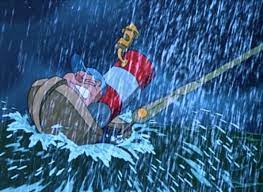 Toot is at first caught by surprise by this, and almost goes under as the loop lands upon his deck. However, he rights himself, sets himself to pull, and gives it his all, tugging and tugging repeatedly to set the ship free. A bolt of lightning crashes down, striking Toot in the stern. The shock gives him an extra jolt of energy, as his bolting move forward suddenly breaks the ocean liner free of the rocks, allowing Toot to race forward with the mighty ship following him. For a moment, the tide literally turns, and a giant wave crashes across Toot’s bow, deluging the little tug, until all that we see is one of his life preservers floating on the surface. A curious seagull lands on the preserver, and peers down through the center hole into the water for any sign of Toot. His curiosity is answered by a blast of soot in the face from Toot’s smokestack, as the little tug blows sea water out of its belly, and rises to the surface again – still with the ocean liner hooked in tow behind him. Toot proudly pulls the massive ship into harbor, amidst the forgiving cheers of the other tugs, who pronounce him a hero. Perhaps proudest of all is Big Toot, who knows that the family name will no longer be regarded in disgrace. Little Toot smiles a beaming smile – but happily displays one war wound – a large bandage, wrapped around his stern end, protecting the tender rear that got hit by the lightning blast. He continues with a pronounced wiggle of his prominent stern, as the song concludes and the scene fades out.
Toot is at first caught by surprise by this, and almost goes under as the loop lands upon his deck. However, he rights himself, sets himself to pull, and gives it his all, tugging and tugging repeatedly to set the ship free. A bolt of lightning crashes down, striking Toot in the stern. The shock gives him an extra jolt of energy, as his bolting move forward suddenly breaks the ocean liner free of the rocks, allowing Toot to race forward with the mighty ship following him. For a moment, the tide literally turns, and a giant wave crashes across Toot’s bow, deluging the little tug, until all that we see is one of his life preservers floating on the surface. A curious seagull lands on the preserver, and peers down through the center hole into the water for any sign of Toot. His curiosity is answered by a blast of soot in the face from Toot’s smokestack, as the little tug blows sea water out of its belly, and rises to the surface again – still with the ocean liner hooked in tow behind him. Toot proudly pulls the massive ship into harbor, amidst the forgiving cheers of the other tugs, who pronounce him a hero. Perhaps proudest of all is Big Toot, who knows that the family name will no longer be regarded in disgrace. Little Toot smiles a beaming smile – but happily displays one war wound – a large bandage, wrapped around his stern end, protecting the tender rear that got hit by the lightning blast. He continues with a pronounced wiggle of his prominent stern, as the song concludes and the scene fades out.
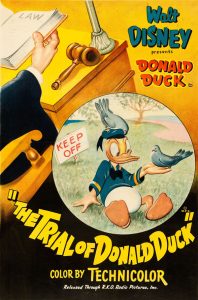 The Trial of Donald Duck (Disney/RKO, Donald Duck, 7/30/48 – Jack King, dir.) – Told largely in flashback via the evidence summation of a defense attorney in a courtroom, the tale of woe of the accused, Donald Duck, is presented. This is another story that begins from “ducking” into a “most convenient door” when a rainstorm breaks out in the park. Blue collar worker Donald, who had been intending to enjoy his lunch packed in a metal lunch box, finds himself at the doorway of a fancy French restaurant, Chez Pierre. Not knowing the place or its classy reputation, he enters, intent on merely obtaining a cup of coffee to go with his lunch.
The Trial of Donald Duck (Disney/RKO, Donald Duck, 7/30/48 – Jack King, dir.) – Told largely in flashback via the evidence summation of a defense attorney in a courtroom, the tale of woe of the accused, Donald Duck, is presented. This is another story that begins from “ducking” into a “most convenient door” when a rainstorm breaks out in the park. Blue collar worker Donald, who had been intending to enjoy his lunch packed in a metal lunch box, finds himself at the doorway of a fancy French restaurant, Chez Pierre. Not knowing the place or its classy reputation, he enters, intent on merely obtaining a cup of coffee to go with his lunch.
The owner, personally presiding as maitre d, ushers Donald to a table, where candlelight is lit, and a wide variety of silverware is spread before him. Donald fails to note a small placard at the candle’s base, reading “Cover Charge – $5.00″, so we already know he’s in trouble. Pierre claps a signal to an orchestra, which strikes up salon-style background music. Ignoring the indecipherable French menu recommendations of Pierre, Donald requests coffee. “Demitasse?” asks Pierre. “Java”, replies Donald. Pierre exits to the kitchen, while Donald busies himself by attempting to polish spots off the silverware. Pierre return with a cup so small, Donald’s eyes widen to a dimension three times the cup’s diameter. The cup is “filled” by what amounts to a spit out the spout of Pierre’s pot. Finding only a single drop for his serving, Donald begins to show his true colors, leaping onto Pierre’s chest. “Hey, where’s my coffee? I’ll call the cops. I’ll crucify ya!” Pierre attempts to maintain his cool and is apologetic. But while waiting for a refill, frustrated Donald thrusts away the silverware and plate, and instead spreads out the contents of his lunch box across the table. “What is thees!!”, shouts Pierre. “Monsieur, we cannot allow…” Then Pierre pauses. “Or can we?” Glancing over Donald’s table, he adds to the bill for coffee a charge for every item Donald has brought for lunch – as if Pierre had served them himself. Pierre leaves the check on Donald’s table – for a whopping $35.99! Donald, with only a nickel in his pocket, pleads for reasonableness from Pierre, but finds him cold (transforming into an ice statue) and hard (transforming into stone). Defense counsel states that Donald, with “magnificent restraint”, voiced a “timid protest” – in fact, the long-awaited trademark temper tantrum. But Pierre wraps him up in the tablecloth, and hands him over to the authorities. From behind a railing resembling prison bars, the camera returns to view of Donald in the courtroom. As Pierre is fingered by the counsel as the “real culprit”, Pierre objects. Ignoring all formality, the judge rules, “Shut up!” Counsel throws himself and Donald upon “the mercy of the court”. Verdict is rendered from the bench – ten dollars or ten days washing dishes – or else. Now the judge illustrates with the window’s Venetian blinds, readjusting them to cast prison stripes across Donald’s shirt. Not having the ten dollars, Donald opts for the dishwashing gig. However, Pierre quickly learns that his hard-fought vengeance was a mistake – as Donald gingerly engages in breaking every dish he encounters. Pierre begs with Donald, forgiving him, offering to pay him, and feed him, if he’ll please stop washing dishes. “You heard what the judge said! TEN DAYS!” shouts Donald, as the plates continue to fall amidst Pierre’s hopeless moans, for the iris out. (Notably, the setup for this film would be well remembered by other studios, with Woody Woodpecker also ordering coffee in a French restaurant in “A Fine Feathered Frenzy” (1954), and Yogi Bear as a “good will ambassador”, causing an international incident by smothering a French chef’s creation in tomato catsup, in “A Bear Pair” (1961).)
The climate’s still not fine, as we move into ‘49, next time.


 Charles Gardner is an animation enthusiast who toils by day as a member of LA Law – but by nights and weekends indulges in classic jazz and ragtime as a performer; and studies classic Hollywood cartoons… maybe a little too much.
Charles Gardner is an animation enthusiast who toils by day as a member of LA Law – but by nights and weekends indulges in classic jazz and ragtime as a performer; and studies classic Hollywood cartoons… maybe a little too much.


































































































































































I don’t recall ever seeing “Nothing but the Tooth” before; not since early childhood anyway. What a scream! I really wish Warners had kept the Art Davis unit around for a few more years.
I was amused that Pluto had to deliver the mail bag to “Quagmire Airport” — Quagmire, of course, being an airline pilot on “Family Guy”. Giggity!
I think the statue in the final scene of “Winter Draws On” is meant to be a generic Southern gentleman rather than Andrew Jackson. For one thing, the statue is bearded, whereas Jackson was clean-shaven; for another, Jackson was born in 1767 and died in 1845, while the statue’s pedestal bears the dates 1812-1888. When it comes to Confederate war heroes with those dates, the list begins and ends with Colonel Alexander Ross Taylor of South Carolina; but he was a minor figure, and I doubt that there’s a statue of him anywhere in the South for anyone to clamour to have removed today. I refuse to entertain the possibility that it’s a statue of Edward Lear.
Along with taming a tornado, Pecos Bill was also involved in another feat of weather manipulation. To stop a drought in Texas, he lassoes all the rain clouds over California and brings them over, the resulting deluge creating the Gulf of Mexico. And if that wasn’t enough, he shot all the stars except for one, which is why Texas is the Lone Star State.
“A Fight to the Finish” (Terrytoons, Mighty Mouse, 14/11/47 — Connie Rasinski, dir.), the first of the Mighty Mouse melodramas with Pearl Pureheart and Oil Can Harry, begins with a storm raging outside a tiny railroad station where Harry and our hero are duking it out. Pearl, meanwhile, is tied up in the next room but refuses to give up Hope (“He’s my favourite radio comedian!”). A bolt of lightning strikes the station, setting it afire; then Harry knocks out Mighty Mouse with a convenient can of poison spray. Harry escapes with Pearl, leaving the unconscious Mighty Mouse tied to the railroad tracks outside the burning station, a bomb balanced on top of his face, just as the 5:15 is about to arrive. Yet in the very next scene, the weather has cleared up to the point that Harry can drive away in his convertible with the top down!